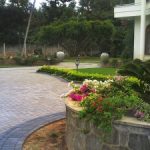-
Icon in Pakistan
July 2013

Icon is C Anjalendran’s latest built work in Pakistan and his second project outside Sri Lanka. Designed as a flagship department store for the Ghouri family, the building is located in the town of Sukkur in Pakistan’s Sindh Province, 500 km north-east of Karachi. Although regarded as a backwater, Sukkur is sited on the banks of the Indus River and is home to significant Mughal tombs and monuments. The small 20-perch site is located in the centre of the town, adjacent to the magnificent 400-year old Baradari (pleasure pavilion) and minaret of Masoom Shah Jo Munaro.
By Rajiv Wanasundera | Photography Shajee (Karachi)
Declined by three Karachi firms, Aamir Ghouri finally approached Anjalendran, on a friend’s recommendation. Anjalendran subsequently requested for photographs of the site, and seeing the two beautiful monuments next door, accepted the commission by telephone, not having met the client or seen the site in person!
The brief called for a 4,500 square foot structure, containing retail and related office space. Anjalendran travelled to Pakistan in November 2008 with a schematic design and spent six days on site. After his initial design concept was approved he worked with a local engineer developing the construction drawings in AutoCAD before returning to Sri Lanka.
Construction commenced in 2009 and was completed 18 months later. Objections from the local council given the building’s proximity to archaeological monuments meant that the upper-most floor had to be removed. The building was fully occupied in 2012. Anjalendran’s involvement during the construction process was limited to answering construction related questions via e-mail and reviewing construction progress via photographs. The project was completed without any additional site visits by him, although the client did visit Sri Lanka twice to seek guidance on various issues.
The completed building is three storeys tall and built to the boundaries of the site. In plan it appears to be a simple nine-square grid. Subtle variations are inflected on the plan to create spatial complexity. The centre square contains a three-storey atrium with a monumental staircase and a skylight above. The entrance is in the square at the north-west corner of the site, which is diagonally bisected to create a generous shaded three storey tall entry portico with a view towards the nearby monuments. The north façade facing the street is a double-screen wall of pierced decorative concrete blocks with a secondary wall three feet beyond, to induce stack effect ventilation. Similarly, at the back of the building, two small planted courtyards introduce cooling greenery and allow hot air to escape from upper floor windows. The building is an example of how to build in a desert climate by shielding the interior from the harsh sunlight, allowing the free flow of cooling breezes at low level and using double screen walls to vent hot air through stack effect from the upper floors. The building continues to function well with natural ventilation and electric fans.
The completed building is three storeys tall and built to the boundaries of the site. In plan it appears to be a simple nine-square grid.
The materials used are durable and elegant. The decorative concrete blocks for the screen wall are locally sourced. The veneer on the front façade is Italian ceramic tiles, which the client had originally wanted to use as flooring. Anjalendran, inspired by the nearby Mughal monuments with their colourful tile insets, suggested that the tile be used instead on the exterior wall.
The finishes on the interior are simple white plaster walls and white ceramic tile floors. There are plans to install a suspended sculpture of birds crafted out of copper sheets in the atrium to tie the space together.
Icon is unusual for a department store in not having any street-facing glass display windows. However, in Anjalendran’s words, “in the desert heat, this would be madness.” The introverted quality of the building is popular with Islamic women customers who value the sense of privacy that the design offers. The elegant cubic volume of the building stands in respectful contrast to the soaring minaret and pleasure pavilion next door. Notwithstanding its name, Anjalendran never set out to design an iconic building. His credo, following his mentor Geoffrey Bawa, has always been to: “respect nature; show restraint; never do architecture that is iconic or in your face.”
The building has been favourably received with the client calling it “a dream come true.” Professor Senaka Bandaranayake complimented the project for its “architectonic forms, not only beautiful functional spaces” and adds that it is “a step in the history of modern South Asian architecture.”
With Icon, Anjalendran has demonstrated that the principles used to design climatically appropriate buildings in tropical monsoon Asia can also be successfully deployed to other climatic zones. The lesson for local architects is that if you deal in principles rather than dogma, building suitable buildings outside Sri Lanka should not be a problem. Within its deceptively simple façade and plan lies a building which is both spatially complex and superbly adapted to its location. It is an architecture which appears effortless, yet it is the result of sensitivity to culture and climate honed over 30 years of independent practice.
Principle Architect/ Architectural Firm: C Anjalendran, Sri Lanka
Other persons involved: Collaborating Architect: Usman Siddiqui, Sukkur
Structural Design: M/S Qamar Javed Associates, Karachi
Electrical Design: M/S Excellent Associates, Karachi
Site Supervisor: M Shahid Baboo Bha
Contractor: Jamal Abbassi, Sukkur
Client: Aamir Ghouri, Sukkur, Pakistan











